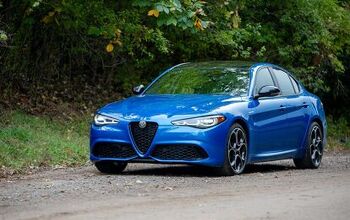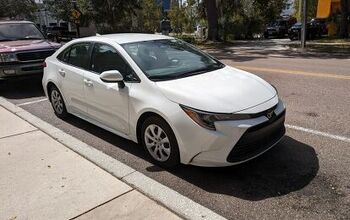The Honda HR-V Did Not Kill The Honda Fit After All, Thank Goodness
Within months of the Honda HR-V arriving in North America, it seemed as though the Honda Fit was dead to rights.
Last summer, U.S. sales of the Honda Fit tumbled 35 percent as the starting point of a second-half in which Fit sales would plunge 54 percent.
The cause was obvious, or so it seemed. Consumers don’t want subcompact cars, consumers want subcompact crossovers.
With the subcompact crossover, the Honda HR-V, lining up alongside the subcompact car, the Honda Fit, inside Honda showrooms, consumers were driving away in HR-Vs 80 percent of the time.
Fast forward one year: it seems as though Honda has remedied the situation. Not only are U.S. sales of the Fit rising rapidly, the Honda HR-V continues to strengthen its share of the American subcompact crossover market.
How’d they do it? Don’t tell a certain presidential candidate, but it’s all because of Honda’s Japanese-Mexican arrangement.
Known in these parts as the worst current Honda product, the Honda HR-V nevertheless generated more U.S. sales in its first seven months on the market than its Fit platform-sharing sibling did in the whole of calendar year 2015. From the perspective of the Fit, one of its segment’s freshest products, the HR-V’s launch period was a disaster.
After averaging nearly 5,800 monthly Fit sales in the year leading up to the HR-V’s launch, Honda then sold fewer than 3,500 Fits per month in the six months after the HR-V’s launch.
POST HOC ERGO PROPTER HOC
The assumption: America’s growing appetite for crossovers, combined with America’s decreased demand for small cars, was causing consumers of Honda’s magic-seated subcompacts to choose the HR-V four times out of five.
The assumption was incorrect.
Recalls plagued the third-gen’s Fit early tenure. Then inventory dried up. From a 79-day supply of Fits two years ago, Honda only had 27-day supply of Fits a year ago.
In other words, the Honda Fit was struggling because Honda didn’t have enough Fits. The Fit, your punny Dad would say, was not fit to serve.
DON’T TURN THAT BOAT AROUND
The Fit’s rising inventory comes not as Fit sales dwindle, but rather as Fit volume surges. Year-over-year, sales of the Fit during the last three months grew 33 percent. American Honda has reported more than 5,000 Fit sales in five consecutive months after averaging 3,000 monthly sales over the previous eight months. August volume jumped 85 percent.
Month to month, Fit sales have improved in five of the last seven months, rising to a 14-month high in July. At the current rate of growth, Honda will report in 2016 more than 60,000 Fit sales for the first time since 2009.
So, a year ago, Honda’s HR-V emphasis brought the Fit low. Is the reverse true this year?
Not at all. Coinciding with the Fit’s improvements are increased HR-V sales. After its first-full-month performance of 7,760 sales in June 2015, limited supply also hampered HR-V volume for many months. But HR-V inventory is ramping up, and American Honda reported 7,580 HR-V sales in August 2016, a 14-month high. Over the last four months, HR-V sales have jumped 18 percent, year-over-year.
Heading into September, Automotive News said American Honda had 27,000 HR-Vs in stock, the greatest level of supply since Honda’s subcompact CUV was launched.
LAND OF THE RISING FIT
Of the HR-V and Fit, American Honda spokesperson James Jenkins tells TTAC, “We are seeing a good production level that is getting closer to overall customer demand.”
Last year, the Celaya, Mexico, facility tasked with bringing HR-Vs to the American market was also responsible for delivering Fits to the United States. But fast forward to the present and 96 percent of the Fits sold in the United States in August 2016 were imported from Japan. Yes, that Japan, where the first two generations of Fit were sourced before Honda began building the third-generation Fit in the Mexican state of Guanajuato.
Assembly of Japanese-built Fits destined for U.S. consumption began one year ago at a long-awaited plant in Yorii. Fit production switched in May 2016 to a plant in Suzuka “to optimize the volume distribution,” said Honda’s Jenkins.
Regardless of their origins, it’s clear that American Honda’s dealers now have Fits and HR-Vs to sell. The duo combined for 12,950 U.S. sales in August 2016, up 73 percent from August 2015. Only 1 out of every 20 Hondas sold in the U.S. in August 2015 were Fits and HR-Vs. That figure jumped to 1 in 10 in August 2016.
After briefly sharing a bedroom, the Honda HR-V did not kill its older brother. The HR-V merely asked the Fit to move into an apartment on the other side of town.
Now the siblings get along fine.
[Images: American Honda]
Timothy Cain is the founder of GoodCarBadCar.net, which obsesses over the free and frequent publication of U.S. and Canadian auto sales figures. Follow on Twitter @goodcarbadcar and on Facebook.
More by Timothy Cain
Latest Car Reviews
Read moreLatest Product Reviews
Read moreRecent Comments
- Calrson Fan Jeff - Agree with what you said. I think currently an EV pick-up could work in a commercial/fleet application. As someone on this site stated, w/current tech. battery vehicles just do not scale well. EBFlex - No one wanted to hate the Cyber Truck more than me but I can't ignore all the new technology and innovative thinking that went into it. There is a lot I like about it. GM, Ford & Ram should incorporate some it's design cues into their ICE trucks.
- Michael S6 Very confusing if the move is permanent or temporary.
- Jrhurren Worked in Detroit 18 years, live 20 minutes away. Ren Cen is a gem, but a very terrible design inside. I’m surprised GM stuck it out as long as they did there.
- Carson D I thought that this was going to be a comparison of BFGoodrich's different truck tires.
- Tassos Jong-iL North Korea is saving pokemon cards and amibos to buy GM in 10 years, we hope.





































Comments
Join the conversation
I got one of the last 2016 manual Fits available, they had to truck it in from over 700 miles away. That was in February, they'd run a lot of manuals, then a lot of CVT's and shut the plant down and moved it to Japan a few months prior. Anyone who speculated that the HR-V killed the Fit was talking out of their ass.
Honda dropped the ball on the fits styling big time. The previous generation was much more appealing. I suspect that might have something to do with it.